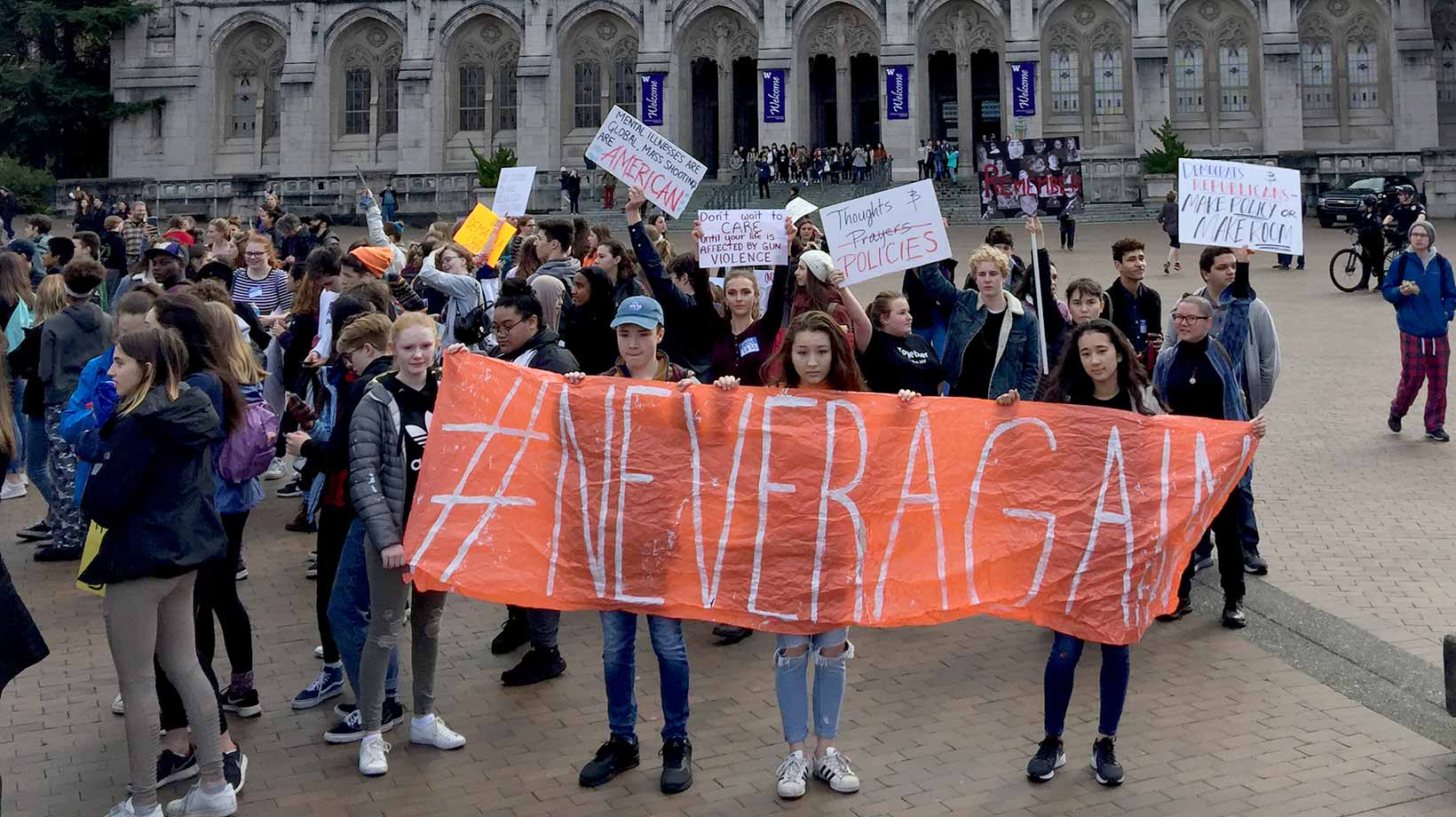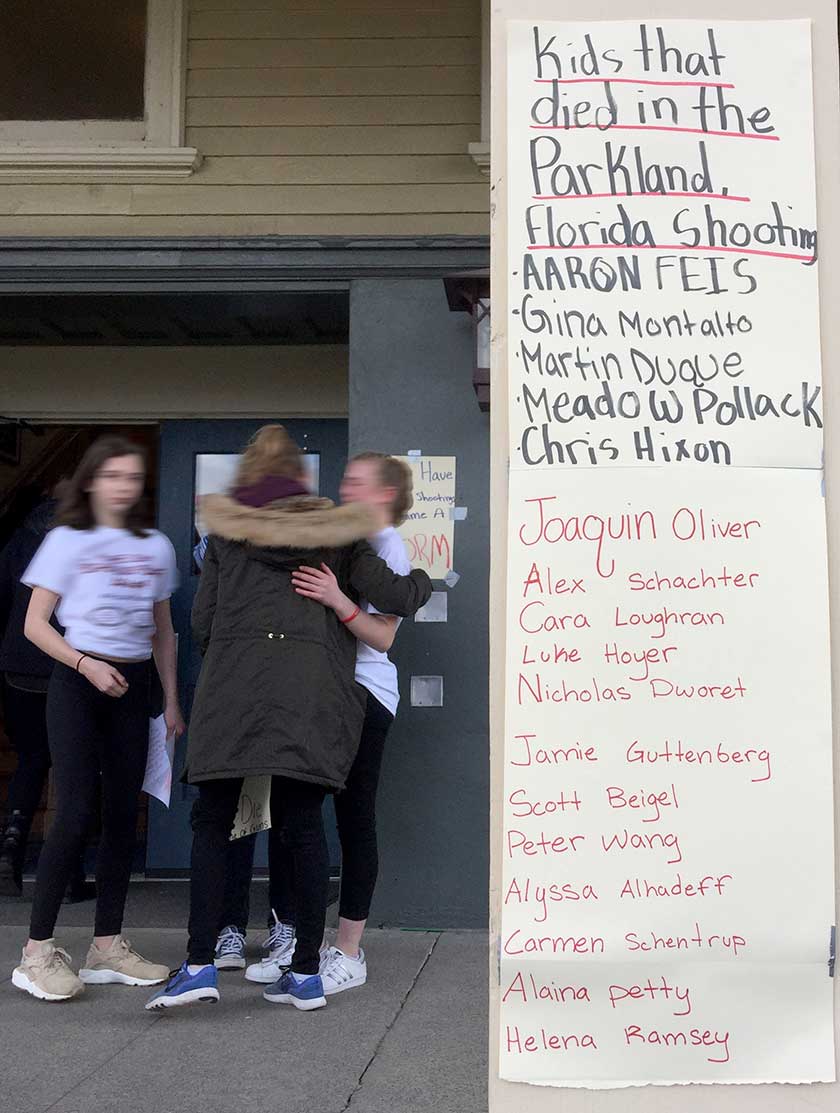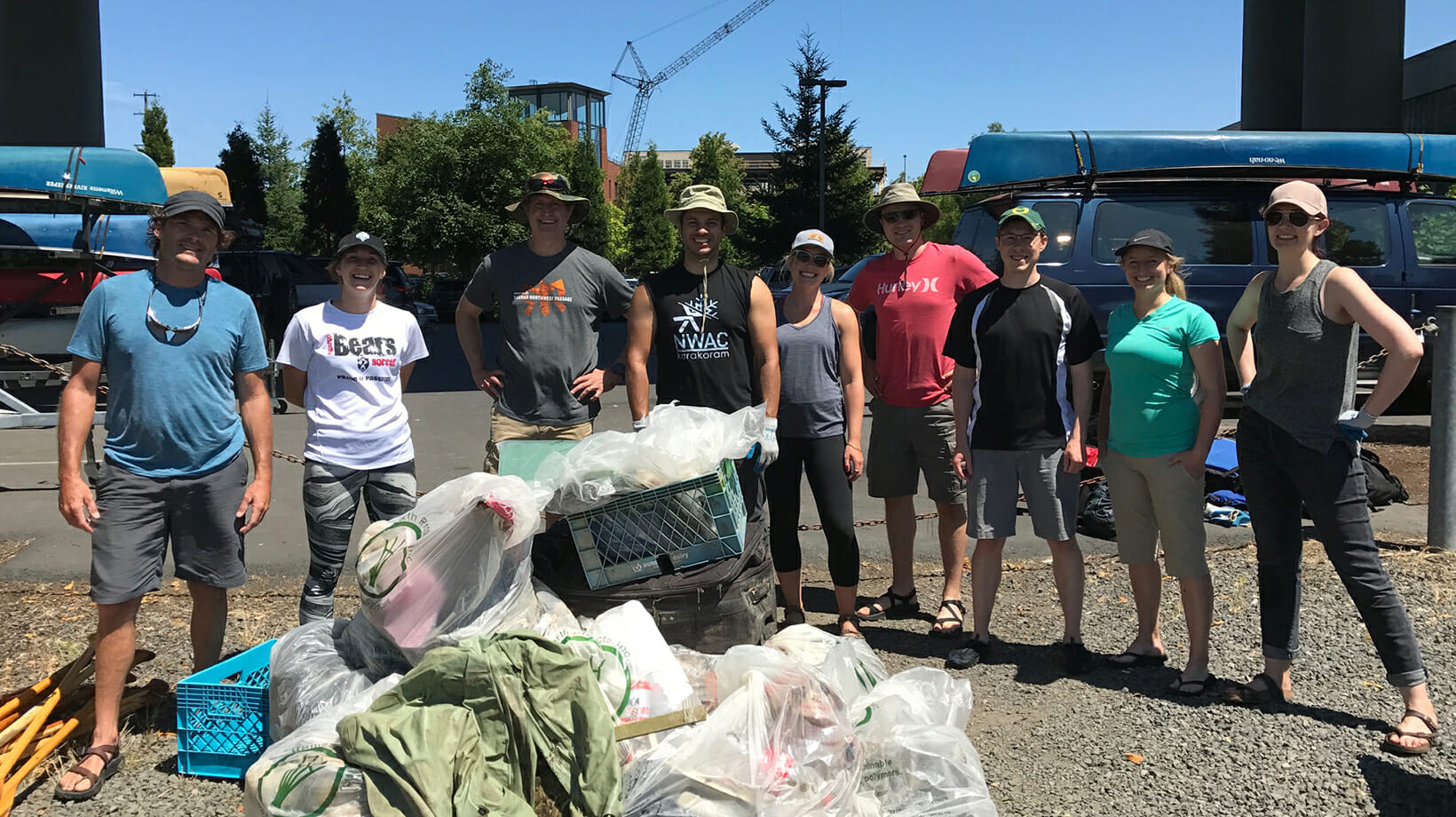We at Mahlum believe that every person on the planet is deserving of safe, secure places to live, work and learn, and we especially believe that no student should have to worry about endangering their lives by simply heading off to school in the morning.
Our firm is dedicated to creating spaces for students to discover, create, grow and develop. We design shared classrooms so different ages can work together and learn from each other – we add transparency so that teachers and pupils feel a sense of camaraderie. We include outdoor learning stations and environmentally sustainable elements because we understand how important a connection to and responsibility for the earth is to young learners. We do everything we can to create an ideal space for young minds to begin to grasp their unlimited potential and power – but we’ve learned that we can’t always protect them. Which is why we need to do something. March for Our Lives is happening on Saturday, March 24th. The event, organized by the survivors of the shooting in Parkland, Florida, is part of a larger movement for better gun safety measures. And with almost 700 connected events occurring on the same day worldwide, it seems that everyone understands that now is the time for something to happen. As they write on the March for Our Lives website, “School safety is not a political issue. There cannot be two sides to doing everything in our power to ensure the lives and futures of children who are at risk of dying when they should be learning, playing, and growing.” These kids inspire us (and the country) to finally take action and demand that Congress address gun issues and the gun violence that continuously returns to the classrooms of the United States. We need to show these kids that we’re finally listening – which is why we’re encouraging our staff to participate in this monumental event. You can find the closest event to you here, or you can make a donation to the cause if you’re unable to attend. Stand With Us at March for Our Lives.



Author: Mahlum
Engagement to Yield Empowerment
Though all of us are trained in design, we’ve discovered that an intentional process of engaging users and stakeholders is the only way to assure that those whose lives will be most affected by the outcome have influence on how design unfolds to serve their needs.

A successful process should enable and inspire dialogue, facilitate decisions, and build enthusiasm and advocacy for the ideas explored. And it should be fun!

We consistently integrate creative, playful, and participatory engagement strategies into our planning process, including both high-tech and hands-on approaches to outreach. Our dynamic process invites broad stakeholder participation within a rigorous framework.
Mahlum has extensive background facilitating large constituent groups, often with highly diverse stakeholder representation. As experienced leaders of the design process, we are skilled at both consensus building and providing advocacy for complex and sometimes emotionally charged projects.
Engagement strategies are implemented throughout our process in order to garner both quantitative and qualitative information from a wide variety of constituents through a series meetings, interviews, observation sessions, activities, tours, and generative committee and/or community workshops.
We have developed a series of interactive tools designed to both provide information and gather feedback with the aim of identifying needs and prioritizing goals. Exercises that can be employed are targeted at a range: individual, small group, and large group engagement. Our team is also especially adept at developing custom engagement activities, if required, to help the committee or community identify and resolve issues critical to each school’s vision for the future of education. Information will be synthesized, communicated and refined into project goals, district needs, and options, all of which will inform and shape a project.
From the standpoint of facilitation, one particular tool, the design workshop, has proven highly effective. It has been our experience that these workshops give various participants a better understanding of the concerns and hopes of other constituent groups, an appreciation for the difficulty of resolving all issues perfectly, and a feeling that they have contributed to the eventual outcome. Having participated in the decision-making process, they become advocates for those decisions and ultimately ambassadors promoting the success of your project.
The Story of the Murals Preserving beloved cultural assets became an integral part of a new vision for a new school. The shared-use, 16.9 acre campus is designed to accommodate Seattle Public Schools rapid growth, housing three distinct programs for 1,660 students at Cascadia Elementary School, Robert Eagle Staff Middle School and Licton Springs K-8. The site also houses a city-run preschool facility, athletic fields, upgraded pedestrian and bike amenities, and ~$1.5M of neighborhood flood control infrastructure developed in conjunction with SPU & SDOT.
In the design process, cultural assets valued by the community needed to be considered. Painted by a local Native American artist on the walls of the original school building – which in the past housed a Native American school program – the murals at Wilson Pacific were at first slated to be demolished. However, over time these un-designed landmarks depicting Native American figures and Native culture had become part of the surrounding neighborhood’s character and were genuinely cherished by the local community, which strongly opposed their destruction. The decision was made, late in the Design Development phase, to preserve the murals and incorporate them into the new campus as part of both the new Elementary and Middle School buildings.



Working in collaboration with renowned Native American architect Johnpaul Jones of Jones & Jones Architects, the design and construction teams determined it would be unfeasible to arrange the project around the mural’s existing locations, which was the most economical option. That conclusion led to the development of a strategy to secure, cut, move, store, and attach to the forthcoming structural frame, eight enormous CMU and precast concrete walls without damaging their painted surfaces. This also meant the sections of wall where the murals would be relocated had to be built in the opposite order of a regular exterior wall, from the outside in, generating significant construction sequencing and detailing challenges.
This story shows the value we place as a firm in collaborating with the owner, consultants, and general contractors throughout all phases of design and construction. It shows how we value listening to our communities and changing course when we recognize our design approach might not be entirely right, even if that goes against the original program and budget. That we have the ability and courage to face unique technical challenges in our work – when was the last time you had to cut and move a giant mural to build wall? In essence, it shows how much we care.
Regardless of what one might think of the mural’s artistic value and the high financial cost it took to accomplish this preservation effort, what we’re most proud of in this process is the fact the community’s voice was heard, a neighborhood’s character respected, and a culture who is used to seeing their history and achievements devalued and erased was recognized and brought to center stage.
Background of Robert Eagle Staff
Read the Seattle Times article: New Seattle school honors Native visionary Robert Eaglestaff
Read article
via Jesse Walton
The history behind school lunches is shared this week on Gastropod.
Find out more about surplus meat and locally grown veggies. Check out this story: https://gastropod.com/lunch-gets-schooled/
Each year we gather our 90+ staff to connect, reflect, and strategize, strengthening bonds between our two offices and finding inspiration in our shared purpose. As we gathered in Portland this summer, we also included a day of service to help increase health and well-being in our community.
In alignment with our vision – empowering communities to assure health & well-being for all – we offered our services to 12 non-profit entities in the Portland area. We split our office up into groups of 7 to 9 people per organization, and our staff spent time educating themselves before venturing on to the non-profit. We asked that all of our staff ask themselves the following questions during their time volunteering: We also documented our time spent with these organizations through video, hand sketches, still photos, music, and poetry. Every group gave a presentation to share their experience with the entire office. As individuals, professionals, and a design team, we were awed and humbled by the people and organizations we helped. This work is never done, and we look forward to engaging with these and other non-profits in the future. It is our desire to help create healthy and sustainable places in all that we do. We hope you will also find inspiration in one of these groups to make a difference in the community.
Joining Forces for Community Impact



via Niki Lesko
Mahlum’s Portland office was recognized again in 2017 with a Sustainability at Work GOLD certification by the city of Portland. You can find our profile and sustainable office strategies at www.portlandoregon.gov under Mahlum | Architects, Engineers, and Designers.
via Rachel Auerbach
I’ve often wondered why green infrastructure seems so brown. This is a great article that makes me wonder what we can do with our landscape architects, civil engineering, and jurisdictions about having more successful storm water gardens, bioswales, and retention areas.
Check this out: https://www.thomasrainer.com/blog/2017/3/25/green-infrastructure-10-has-failed
 In our ongoing commitment to community, Mahlum continues advocacy for design of homeless shelters that not only provide safe shelter but enhance resident feelings of security and well-being. Beginning in 2011, Mahlum selected Washington State Coalition Against Domestic Violence (WSCADV) as the recipient of pro bono architectural services. WSCADV’s goal was not to create a building, rather to create design guidelines for shelters serving women seeking to break the cycle of violence in their lives and their children’s lives.
In our ongoing commitment to community, Mahlum continues advocacy for design of homeless shelters that not only provide safe shelter but enhance resident feelings of security and well-being. Beginning in 2011, Mahlum selected Washington State Coalition Against Domestic Violence (WSCADV) as the recipient of pro bono architectural services. WSCADV’s goal was not to create a building, rather to create design guidelines for shelters serving women seeking to break the cycle of violence in their lives and their children’s lives.
As part of the process, we engaged with diverse WSCADV stakeholders, listened and studied intently, and then endeavored to translate challenges and issues into a range of possible design strategies that span the continuum from redecorate to rethink. In particular, we:
- Reviewed and assisted in analyzing data from focus groups and interviews with domestic violence survivors (both women and children), shelter advocates and managers regarding experiences of a variety of shelter environments;
- Complemented focus groups with first-hand observation during several shelter visits;
- Facilitated “Think Tanks” that brought together people with a variety of perspectives and expertise to generate intensive conversation, critique progress, and brainstorm where projects might go.
Website: http://buildingdignity.wscadv.org/
More About the Website
The product of this year-long collaboration is an interactive, tool -– Building Dignity: Design Strategies for Domestic Violence Shelter – which assists advocates, shelter staff, fundraisers, and the design community to improve the quality of life for survivors and their families, within the state and throughout the country. Building Dignity is an opportunity to illustrate how our problem solving skills, as architects, can serve those who might not normally seek us out (even if it’s not a building that’s needed). We aspire to show, through the design and collaboration process, how domestic violence housing programs can shape the built environment to reflect and complement their mission and values. Thoughtful design can help empower parents, support children’s needs, and facilitate healing. It can help survivors rebuild a sense of dignity and allow staff to focus on providing survivor-centered advocacy.
via JoAnn Wilcox
This study, Planning and Building Healthy Communities for Mental Health: Method, findings and reflections from a recent integrative study, published in the Journal of Urban Design and Mental Health Edition 3, concluded that there is a need for more empathic engagement by designers and managers to their task, where they ‘put themselves in the shoes’ of residents to create environments that accurately meet health needs and ensure uptake is actually achieve.
It also suggests a critical and much needed follow-up question: Just why is it that we seem to lack these necessary levels of engagement in our city building processes, ultimately to the detriment of the well being of us all as city residents, users, and practitioners?
via PJ Bauser
We’re getting ready to start some work where we’ll be investigating new clinic models for a clinician’s group that is used to some traditional spatial and work organizations.
I think this article offers a great reminder that we need to first observe how the care givers actually work and what they are trying to accomplish so that we can understand their requests and work together to develop solutions that support their actual needs.
